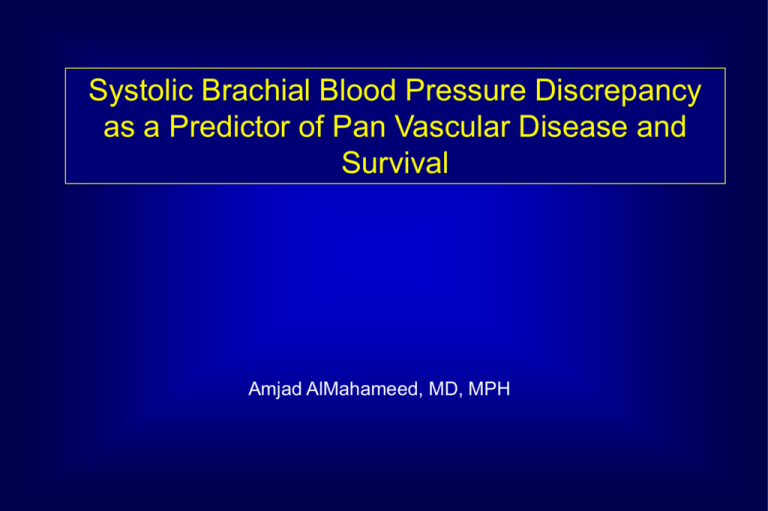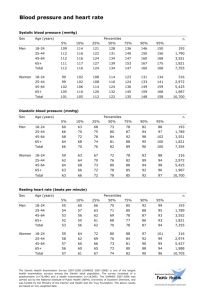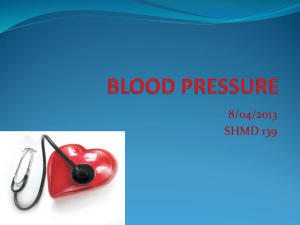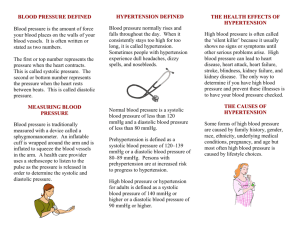Pulse Volume Recordings and Ankle Brachial Index
advertisement

Systolic Brachial Blood Pressure Discrepancy as a Predictor of Pan Vascular Disease and Survival Amjad AlMahameed, MD, MPH Time Course of Human Atherogenesis Cerebrovasc. Disease Ischemic Heart Disease lumen lumen lumen lumen Lesion initiation No symptoms Leg PAD + Symptoms Time (years) Symptoms What is Peripheral Arterial Occlusive Disease? • Clinical manifestation of atherosclerosis in the peripheral arteries: ▲ Legs (Iliac, femoropopliteal, crural arteries) ▲ Cerebrovascular: extracranial (such as carotids and vertebral) intracranial ▲ Arms (subclavian arteries) ▲ Renal arteries ▲ Mesenteric arteries • > 90% related to atherosclerotic disease . 68 Million Americans with CVD Stroke 4.4 million PAD 8.4 million HTN 50 million And many more to come !! Heart 16.8 million CHF 4.6 mill AMI 7.2 mill Angina 6.3 mill PAD 5-Years Mortality Rates * 80% of fatal events are cardiac or stroke 86% 100% 80% 60% 40% 20% 0% 15% Breast CA 18% Hodgkin's 28% PAD American Cancer Society. Cancer Facts and Figures. 1997 38% Colon CA Lung CA PAD and Relative Risk of Death Relative Risk (95% CI) 10.0 8.0 5.9 (3.0–11.4) 6.6 (2.9–14.9) 6.0 4.0 3.1 (1.9–4.9) 2.0 0.0 All Causes Cardiovascular Disease Cause of Death Adapted from Criqui MH et al. N Engl J Med. 1992;326:381. Coronary Heart Disease PAD Survival as a Factor of the ABI Patients Survival (%) 100 80 ABI >0.85 60 ABI 0.40–0.85 40 ABI <0.40 20 0 2 6 4 Year McKenna M, et al. Atherosclerosis. 1991;87:119-128. 8 10 JNC 7: Treatment Algorithm for Hypertension Lifestyle modifications Not at goal blood pressure (<140/90 mm Hg) (<130/80 mm Hg for those with diabetes or chronic kidney disease) Initial drug choices Without compelling indications Stage 1 hypertension (SBP 140–159 or DBP 90–99 mm Hg) Thiazide-type diuretic for most. May consider ACEI, ARB, BB, CCB, or combination. Stage 2 hypertension (SBP 160 or DBP 100 mm Hg) Two-drug combination for most (usually thiazide-type diuretic and ACEI or ARB or BB or CCB). With compelling indications Drugs for compelling indications Other antihypertensive drugs (diuretic, ACEI, ARB, BB, CCB) as needed. Not at goal blood pressure Optimize dosages or add additional drugs until goal blood pressure is achieved. Consider consultation with hypertension specialist. SBP=systolic blood pressure; DBP=diastolic blood pressure; ACEI=angiotensinconverting enzyme inhibitor; ARB=angiotensin receptor blocker; BB=b-blocker; CCB=calcium channel blocker JNC 7. May 2003. NIH publication 03-5233. Atherosclerotic Plaque: Effect on Hemodynamics Intima Plaque Vessel Lumen Encroachment on the lumen by a plaque has to be relatively extensive before changes in hemodynamics become manifest: - Aorta: 90% - Iliac, femoral, carotid, renal: 70-90% Media Measurement of systolic pressure provides a quantitative, objective, and sensitive index on the occlusive process Systolic pressure is sensitive index of the fall in mean pressure while diastolic pressure does not fall until the stenosis is severe Libby P. Lancet. 1996;348:S4-S7. Carter S, Role of pressure measurement in vascular disease in Bernstein EF, editor, Noninvasive Diagnostic Techniques in Vascular Disease, Mosby, 1985:513-544 Hypertension and BBPD: Why Are we Talking About This? • HTN is a public health problem (50 Million Americans) • HTN is associated with increased mortality and morbidity1 • HTN is a modifiable risk factor: accurate early diagnosis is vital2 • Joint National Committee (JNC-VII)3 • British Hypertension Society (BHS-IV)4 • World Health Organization (WHO)5 Make no mention of which arm to measure BP in or of BBPD and its significance. • Earlier guidelines recommended measuring BP in both arms during the initial visit and using the higher pressure for all future measurements6-10 • Very few practitioners follow even the most critical aspects of BP measurements guidelines leading to under and over dx of HTN10 (1) (2) (3) (4) Stamler J et al. Arch Intern Med 1993;153:598 Perloff D et al. Circulation 1993;88:2460 JNC VII JAMA 2003 Williams B et al. BMJ 2004;328:634 (5) WHO, J Hypertension 1999;17:151-183 (6-10) JNC-V 1993, AHA: Circulation 1967; 36:980 HTN Reviews BMJ 1979 and 1986, JAMA 1995 (11) Cushman Arch Intern Med 1996;156:1922 Occlusive Upper Extremity Arterial Disease • Atheroclerosis • Takayasu’s disease • Embolism/thrombus • Thoracic outlet syndrome • Complication of angiography • Buerger’s disease • Trauma • Aortic disease (dissection, coarctation, syphilitic aortitis, supravalvular aortic stenosis) • No specific number for BBPD has been spelled out as clinically significant in textbooks • BBPD of 10-15 mm Hg should raise suspicion of scubclavian/axilary disease • Differences of 20-30 mm Hg is indicative of disease • BBPD may be seen in patients with no known disease • BBPD may underestimate severity of disease in case of bilateral stenosis Limitation of BP measurement Vessel Wall Rigidity: Limb /Cuff compatibility (pseudo-elevation or -reduction) - More common in L ext. (>10%) - Related to Monckeberg’s sclerosis - Seen in DM, chronic corticosteroid therapy, HD patients, after renal transplantation, neuropathy an surgical sympathectomy - Manifests as incompressibility of the vessel Obstruction in parallel vessels (only higher pressure recorded) Vasomotor tone changes (exercise and heat effect) Time, effort, nonreimbursement issues Effects of Routine Activities on Blood Pressure (adapted from Campbell et al2) Systolic blood pressure Diastolic blood pressure Attending a meeting 20 15 Commuting to work 16 13 Dressing 12 10 Walking 12 6 Talking on telephone 10 7 Eating 9 10 Doing desk work 6 5 Reading 2 2 0.3 1 Watching television 24-Hour Ambulatory BP Measurement Interpreting BP Readings • The following can cause falsely low pressure reading: - An arm cuff that is too wide. - Recent exercise. - Not smoking for a while after heavy, long-term smoking. - BP taken in the flaccid paretic arm • Falsely high pressure can result from the following: - An arm cuff that is too small. - Talking during the test. - Having recently consumed foods or beverages (such as coffee) that raise blood pressure. Historical Perspective: What We Knew • Several studies in the first half of the 20th century found a difference of > 10 mm Hg between arms in 20-45% of patients studied(1-5) Osler 1915: “While the arterial blood pressure in aneurysm is • Most of these studies were small, not standardized, limited to either normal or slightly above, in a majority of cases of hypertensive patients there is a marked difference in the blood thoracic aneurysm pressure in the two arms and when this is greater than 20 • BBPD wasmmHg much less encountered when measurements were obtained it is a point in favor of aneurysm” simultaneously after hypertensive patients rested in supine position for 30 minutes (5% of patients had BBPD > 10 mmHg)(6) • (Osler W. Modern Medicine. Vol 4. Philadelphia, Lea & Fibiger, 1915, P 498) Significant BBPD is present in ambulatory patients presenting to ER without known vascular pathological lesion(7) (1) Cyriax EF, Q J Med 1921;14:309-313. (2) Kay WE and Gardner KD, West J Med 1930;33:578 (3) JAMA 1939;112:2458. (4) Rueger MJ, Ann Intern Med 1951;35:1023-1027. (5) Amsterdam B and Amsterdam AL, N Y J Med 1943,43:2294 (6) Harrison EG, Roth GM, Hines EAZ, Circulation 1960;22:419 (7) Singer AJ and Hollander JE. Arch Intern med 1996;156:2005 2008 Meticulous attention to details is mandatory and the Korotkoff method instruments should be calibrated. Patient should be in supine position. Beware of ABI limitations ABI = ABI is 95% sensitive and 99% specific for PAD BBI = Lower extremity systolic pressure Brachial artery systolic pressure Lower systolic brachial pressure in one arm _____________________________________________________________ Higher systolic brachial pressure in other arm The “Normal” Difference in Bilateral BP Recordings accidental participants (by convenience) included hospital workers (physicians, nurses, janitors, etc) Random BP by 2 observers using standard mercury cuff while seated BP Status Number of participants Average BBPD > 10 Related to sex/ Coefficient age (yrs) (mmHg) hand dominance of variation Normotensiv1 100 38 15% No 5% Hypertensiv2 100 55 18% No 2% Although no objective evaluation of the aortic arch, subclavian or axillary arteries was undertaken, the authors concluded that the 15% and 18% BBPD rate represent “false-positive” results and are related to “normal variability” (1) Pesola G et al, Am J Emerg Med 2001;19:43-45) (2) Pesola G et al, Academic Emergency Med 2002;9:342-345) Assessment of Interarm BP Differences in the ER Prospective observational study on a convenience sample of 610 ambulatory patients seen at a university hospital ER (9/5-23 , 1996) 324 (53%) had a BBPD > 10 mmHg - Patients were seated 113 (19%) had a BBPD > 20 mmHg - Automated BP monitor Mean BBPD was significantly higher in pts w known CAD (14.5 vs. 10.4 mm Hg, P = 0.05) - “Sequential” BP (R arm then L), 300 pts - “Almost simultaneous” BP measurement, next 310 pts BBPD unrelated to age, sex, race, BP , cardiovascular risk factors, pulse, underlying diagnosis Singer AJ and Hollander JE. Arch Intern med 1996;156:2005-2008 The normal Range of Interarm Differences in BP (Orme S et al. Age and Ageing 1999;28:537-542) 462 subjects: 98 with HTN, CAD, PAD (age 68 yrs) and 364 w/o hx of CVD (49 yrs). Supine position for 10 minutes. Mean of 4 simultaneous BP readings (each arm) used for BBPD. Normal Range of BBPD Experimental Some subjects have clinically Important BBPD In Clinical Practice Systolic W/O CVD - 8 to 10.3 (-8.6 to 10.8) - 8 to 11 All Group - 8.7 to 10.9 (-9.2 to 11.4) - 9 to 11 BBPD is not related to age, gender, mean BP, and history of CVD “Normal” range for BBPD (systolic) Is -9 to 11 mmHg Diastolic W/O CVD - 10 to 10 (-10.5 to 10.5) - 10 to 10 All Group - 10.2 to 10.2 (-10.7 to 10.7) - 10 to 10 “Normal” range for BBPD (diastolic) Is -10 to 10 mmHg 400 participants (mean age 56), 86 (21%) with history of HTN. Sit quietly for 5 minutes. BP measured simultaneously using 2 automated monitors. Systolic BBPD: > 10 mmHg: 80 participants (20%) > 20 mmHg: 14 participants (3.5%) Diastolic BBPD: > 10 mmHg: 45 participants (11%) > 20 mmHg: 15 participants (~4%) BBPD was not associated with: Age Sex Ethnicity R or L arm circumference Handedness Being hypertensive Previous history of CVD Participants with Clinically Significant Difference in BP (BBPD) BBPD Quintiles (mmHg), n (%) 0-5 6-10 11-15 16-20 >20 Systolic 231 (57.8) 89 (22.3) 50 (12.5) 16 (4.0) 14 (3.5) Diastolic 284 (71.0) 71 (17.8) 16 (4.0) 14 (3.5) 15 (3.8) Lane D et al. J of Hypertension 2002;20:1089-95 BBPD in Primary Care Patients1 • 237 primary care patients • Systolic BBPD > 20 mmHg: 23% • > 10 mmHg: 40% BBPD in Nursing Home Residents2 • 528 NH residents (able to give IC) • Systolic BBPD > 10 mmHg: 14% • Diastolic BBPD > 10 mmHg: 4% (1) (2) Cassidy P. J Hum Hypertension, 2001;15:519-522. Mendelson G. Cardiology in Review 2004;12:276-278 No association between BBPD (S & D) and: - HTN - Vascular Dz - DM - Dyslipidemia 52 patients (66 yrs) with occlusive or aneurysmal disease documented or suspected PAD (prior surgery, symptoms of claudication, auscultation of a bruit, absent pulses) Cardiac Catheterization With nonselective aortic Arch angiography 35.4% had > 30% stenosis 48 technically acceptable studies 18.7% had > 50% stenosis Gutierrez GR et al. Angiology 2001;52:189-194 1 patient ,total LSC A occlusion 515 patients referred for Cardiac Catheterization 17 (3.5%) subjects had L SCA stenosis (> 60%) 492 had complete Data (age 62) Incidence (%) Overall Population Potential CABG Patients No significant angiographic CAD 1.4 - 1- or 2-vessel CAD 3.3 - - 5.3 1.5 2.4 4.3 6.2 3-Vessel or left main CAD No PAD HTN Smoking history The only independent predictor of L SCA 4.3 or documented) Stenosis: PAD (clinical 6.5 Diabetes Mellitus 6.8 8.3 Cerebrovascular disease 7.6 9.1 11.5 9errorrrrrrrrrrrr 11.8 PAD (30% of participants had PAD) English J et al. Cathet Cardiovasc Intervent 2001;54:8-11 Characteristics of BBPD of > 10 mmHg and > 20 mmHg in predicting L SCA stenosis BBPD > 10 mmHg > 20 mmHg Sensitivity 65% 35% Specificity 85% 94% Positive Predictive Value 13% 19% Negative Predictive Value 99% 98% • BBPD should not be used as screening method for L SCA stenosis pre CABG • Proximal L SCA angiography is recommended for patients with > 10 mmHg BBPD or those with clinical evidence of PAD regardless of the BBPD • If moderate proximal SCA stenosis is present, translesional measurement of the gradient is recommended. English J et al. Cathet Cardiovasc Intervent 2001;54:8-11 134 hospitalized patients: 58 with PAD, 38 with CAD, and 38 controls (no CAD/PAD). The mean of 3 BP measurements (Dinamap) for each arm used for BBPD calculation (sequentially). BBPD (absolute systolic BP ∆ mmHg) > 10 mmHg > 15 mmHg > 20 mmHg > 45 mmHg Control (n = 38) 5 (13%) 0 (0%) 0 (0%) 0 (0%) CAD (n = 38) 6 (16%) 3 (8%) 1 (3%) 0 (0%) PAD (n = 58) 24 (41%)*§ 16 (28%)‡§ 12 (21%)†§ 6 (10%)*§ * P < 0.05 vs. control, † P < 0.01 vs. control, ‡ P < 0.001 vs. control, § P < 0.05 vs. CAD - No relationship between BBPD and sex, age, smoking, HTN, or diabetes. - Relatively high incidence and magnitude of BBPD in the PAD group compared to both CAD and control groups - Does BBPD reflect the atherosclerotic “burden” of a particular patient? Frank SM et al. Anesthesiology 1991;75:457-463. P < 0.0001 • Pairs of BP measurements were taken from 83 of 280 patients (age 69 years) attending general practice (5/94-10/95) • 64% had HTN, 16% smokers, 11% hx CAD, 5% hx of CVA • 11 pta (13%) had S BBPD > 20 mmHg • 14 pts (17%) had D BBPD > 10 mmHg • 5.6 years F/U • 17 pts (20%) had CAD events, 2 had CVA, 6 died (1 from cancer and 5 from CVD) Mean Event-Free Survival (years) Time-to-event survival function plot for clinically important diastolic differences Clark CE and Powell RJ. Family Practice 2002; 19: 439–441. S BBPD > 20 mmHg D BBPD > 10 mmHg 3.5 (vs. 4.9 years for S BBPD < 20) 3.3 (vs. 5.0 years for DBBPD < 10)




